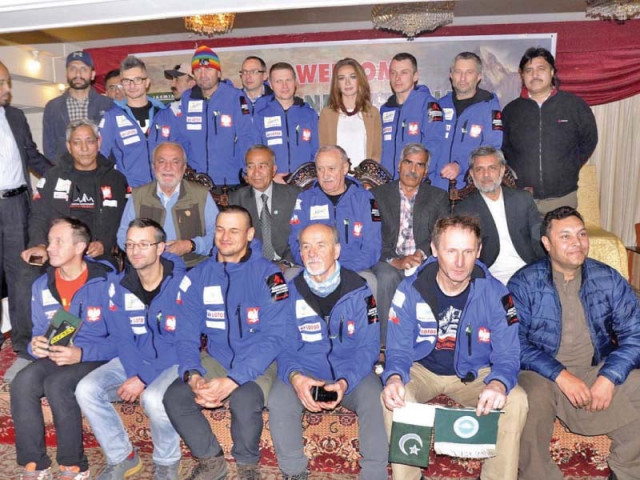Polish team off to conquer K2 in winter
It is the only mountain among 8,000m peaks in world yet to be scaled in winter

Polish team off to conquer K2 in winter
The world’s second highest mountain is the only one left among 14 eight-thousanders yet to be scaled in winter.
The 13-member intrepid adventurers will set off for Skardu from Islamabad on Sunday expecting their names to be etched in the annals of history by successfully climbing one of the deadliest and pristine mountains on earth. Almost half the team has ascended the mountain in summer.
A seasoned climber, 67-year-old Krzysztof Wielicki is leader of the expedition. Previously, Wielicki made two attempts to scale the rugged heights in winter once in 1987 and again 2003 but failed.
After two years, K2 relents
“Half the team has already climbed the K2 [in summer], the rest have tried. The team has experience as some members have conquered the Everest in winter,” Wielicki told The Express Tribune. He has also led winter expeditions to Nanga Parbat in 2007 and Broad Peak in 2013.
Janusz Golab is sporting leader of the expedition while Piotr Snopczynski is base leader. Dariuz Zaluski, a filmmaker; Rafal Fronia, a cartographer; and Adam Bielecki, a psychology graduate are also members of the expedition. All of them are experienced climbers though.
Other members of the team are Marek Chmielarski, Marcin Kaczkan, Artur Malek, Piotr Tomala, Jaroslaw Botor, Maciej Bedrejczuk and Denis Drubko.
According to report published on the website of National Geographic, at the highest peaks of K2, the world's second tallest mountain, wind speeds begin to rival those of hurricanes. Narrow jet streams tear across the mountainside, threatening to take down anyone on its slopes.
British-American woman conquers K2, hoists Pakistan's flag
The wind is just one risk of climbing K2. In winter, temperatures on the 28,000-foot mountain fall below minus 80 degrees Fahrenheit. Daylight lasts for just a few hours. Inclines are some of the world's steepest, said Sarrah Gibbins in the report.
According to the report, 14 mountains in the world reach over 8,000 meters. All have been climbed in winter except for K2, despite attempts that began in 1987, 2002 and 2012. But an elite team of Polish climbers will set off today in an attempt to make history by summiting K2 in winter.
The team, which consists of 13 climbers, will fly from Poland to Islamabad, Pakistan, where they will travel to the country's mountainous border with China. Once there, it will take at least 100 porters to carry over a ton of equipment needed to establish a basecamp.
Only Mount Everest, which stands at 29,029 feet, is taller than K2, whose peak rises 28,251 feet above sea level. Climbers have reached its peak in the spring and summer, when conditions are less perilous, and have partially climbed the mountain in winter, but no one has reached the mountain's peak in winter.
Preparing for history
K2 is a more lethal mountain than Everest, and 84 people have died on the mountain since record keeping began. Only 306 people have ever reached the top, compared to the more than 4,000 that have completed the ascent on Mount Everest.
The Karakoram mountain range to which K2 belongs is colder than the Himalayan mountain range, notes climber and writer Bernadette McDonald, who has authored a book on Polish climbing.
“The combination of difficulty, temperature and wind make it a formidable objective,” she says of the new expedition.
Michał Leksinski, a spokesperson for the expedition, notes that "we have sent someone to space and put someone on the moon, but nobody has ever stood on the top of K2 in the winter."
The Polish team has been preparing for almost two years, purchasing the best climbing equipment and hiring a supplemental team of weather forecasters, dietitians, sports trainers, and doctors.
The climbers have trained in specialized rooms called hypobaric chambers, which allow trainers to manipulate air pressure and to prepare climbers' bodies for the high-altitude, low-oxygen environment of the mountain.
Published in The Express Tribune, December 31st, 2017.


















COMMENTS
Comments are moderated and generally will be posted if they are on-topic and not abusive.
For more information, please see our Comments FAQ